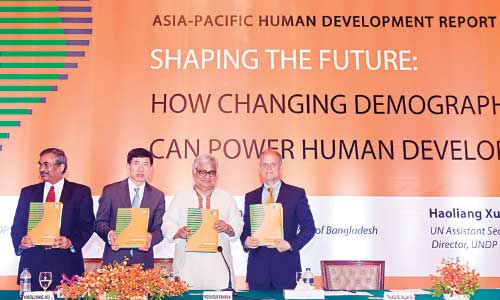B’desh can accelerate growth using youth bulge: UNDP report
Bangladesh is now a home to 10.56 crore of working-age people, creating an excellent opportunity for the country to accelerate its growth by properly utilising the demographic dividend.
According to UNDP’s Asia-Pacific Human Development Report 2016, the proportion of working-age people (15 to 64 years, and 66 per cent of its total population) in the country will increase to 70 per cent or nearly 13 crore of people by 2030.
The report also says the number of old (60+) population is now 7 per cent in the country which will triple to 22 per cent by 2050.
Speaking at a press conference at a city hotel on Tuesday, Thangavel Palanivel, chief economist and senior strategic advisor UNDP’s Regional Bureau for Asia and the Pacific, said Bangladesh is having a youth bulge now with 19 per cent of people aged between 15 and 24.
‘The future of the country depends on how it can build on the skills of youths to enable them to help themselves, and contribute to the development of the country.’
He said a demographic change in Asia and the Pacific happening at a rate the world has never seen. ‘Asia-Pacific countries now have more working-age people and fewer dependents than at any point in the history, providing a springboard for growth. The region-wide 68 per cent of people are working-age and only 32 per cent are dependents.’
‘When the countries have greater share of people can work, save and pay taxes, they have potentials to transfer their economies and power investments in healthcare, education, and other building blocks of future prosperity Thangavel Palanivel.
Earlier, Haoliang Xu, a UN assistant secretary general and UNDP Regional Bureau for Asia Pacific director, launched the report, titled ‘Shaping the Future: How Changing Demographics Can Power Human Development’.
He along with UN residential coordinator and UNDP residential representative Robert Watkins presented the report to Prime Minister’ s economic affairs adviser Mashiur Rahman.
The report says Bangladesh and other countries in the region should spend more on education and healthcare.
At the press conference, Thangavel, also the lead author of the report, said there are many challenges for Bangladesh
government to utilise this demographic opportunities as the degree of unemployment is high in the country and a large number of people are working in the informal sector.
He said Bangladesh should increase its investment for bringing more people to the labour market by providing training and taking other steps for creating skilled man power. ‘Bangladesh needs to create more descent jobs ensuring higher wages and productivity.’
The UNDP economist said the country also needs to get well-thought-out policies in place for the best use of the demographic dividend and prepare for the coming challenges.
Haoliang said if Bangladesh and other countries in the region if do not start planning for this demographic change, they will miss out on a unique opportunity to boost growth and investments for the future.
He said as huge number of working-age population is coming into the market, Bangladesh needs to expand the number of its industries, including export-oriented ones on lather, pharmaceutical textile and other sectors, to capture the market and unlock the potentials of demographic change.
Haoliang said though Bangladesh has made noteworthy progress in primary education, challenges remain for secondary and tertiary education. ‘More resources should be spent on education especially for higher levels to build the future of youth so that they get descent jobs.’
Speaking at the programme, Mashiur said the government of Bangladesh will surely use the potentials of the demographic change as it has already taken many steps to this end.
News Courtesy: www.newagebd.net











